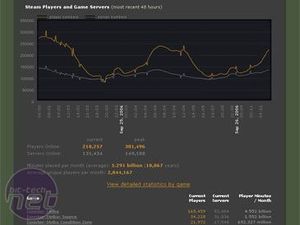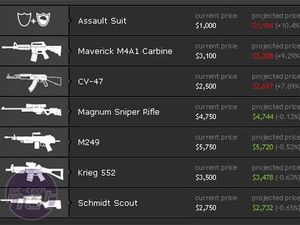The Latest Changes
The first thing Valve did with Source was to get rid of the God awful riot shield, cue lots of "Huzzahs!" from many shield-hating CS'ers. Other changes, such as being able to pick up dropped grenades were also welcomed with glee. Overall, though, the changes were disappointing - maps were tinkered with for aesthetical reasons rather than gameplay balance, new flash bangs were far more powerful (probably more realistic but certainly less fun) and in the initial release the net code made the game close to unplayable.Furthermore, players were unhappy with the hitboxes and the fact that it was harder to stop yourself being headshotted (the one hit kill). Wallbanging (shooting through walls) was also limited which angered those who had spent so many hours working out all the angles to shoot through doors for maximum effect. Many described the initial launch of CS:S as an unfinished game, and that first impression it would seem, has been difficult to shake off.
Valve strode on though, and has introduced other key updates to the game. For one, the developers brought in other classic maps like de_Nuke and cs_Militia. More recently (and controversially), they introduced a new radar system. Gone is the green circle and in came a rectangular box displaying far more info, the routes you can travel as well as little flashes of the enemy if they get spotted. Is this a move that can really coax the old generation into the new game?
Does Valve have a solution?
The real problem I perceive here is that it appears Valve has given up on the old 1.6 community. Some may think this is no bad thing - out with the old and in with the new - but the statistics from Valve itself would suggest otherwise. Right now, almost two years since the release of CS:S there are 34,228 players playing on 31,836 servers. Compare that to the 165,459 people playing CS right now on 83,484 servers. The gap is huge and shows no sign of getting any smaller.So what can Valve do? It is obviously imperative that CS:S take over from Counter-Strike as the leading FPS online game for them, with the Source engine being their flagship platform. In the last few days an even more radical scheme has been drawn up in a hope to make the game appeal to a wider audience. A dynamic pricing system will be implemented that will update itself depending on what the buying trends are in the world of online CS.
This requires a little bit more explanation, which the Steam site provides on the algorithm explanation page:
"Most of the weapons and equipment in Counter-Strike have had the same prices since the day the game was first released. These prices greatly affect the overall balance of the game. We at Valve know we're not alone in thinking that some of the prices in the game have never been exactly what they should be. (Uh, night-vision?) But rather than tweaking the values ourselves, we thought we'd rather let you decide. Coming soon in Counter-Strike: Source is a new system that sets the prices of what you can buy based on, well, what people are buying."
So how exactly will this work? Every week, servers worldwide will upload a file to Steam telling the system how much money people spent on weapons in game. If out of every $100 dollars, $10 went on the AK then the AK's price would rise by 10%. Alternatively if less money is spent on other weapons, like the shotgun, that will fall in price. The ultimate aim is to bring more variety to the game, those of you who don't like using the MAC 10 will now be forced to use it because other weapons will end up being priced out of the market.
Unfortunately for Valve this idea is possibly their most flawed and I think it will make the game awful in so many ways. Imagine this scenario: at the moment many CS:S players don't use the AWP (that's the most powerful sniper in the game for those unfamiliar with CS:S). This is due to many servers banning it and many players describing it as a 'n00b cannon'. However, because less people buy the AWP the price will ultimately drop. At some stage the price will get so low that on any server not banning the weapon, everybody will be using it. Well, they will for that one week anyway. After that week where everyone buys it all of the time the price will sky rocket again, so nobody will use it. Apart from making it difficult to practice with the weapon this will make the game feel inconsistent, like the boundaries are always moving.
Another obvious problem is for those servers which allow for $16,000 start money. Obviously, the results this server would throw up would be a little bit skewed. Other problems include competitive gameplay - how can you devise tactics for a level when one week you'll be able to afford the weapons and the next week you won't? Imagine if, in a football match, one week you fouled someone inside the box it was a penalty but the next week, if you fouled someone one yard outside the box it was also a penalty. Competitive gameplay, the thing that made CS 1.6 so popular, won't appreciate the changing goalposts that this new dynamic money system will impose.
In many ways this update could actually be the end of CS:S and my prediction is that Valve will either change this system so that the economic changes are restricted to only minor changes or will discard it completely. In many ways it appears like Valve is trying to mimic an online world by creating this dynamic economy. In truth, CS:S will struggle even more once this comes into play.
So are there any positives? Unfortunately, at the moment the outlook is fairly bleak. The numbers are against Valve with its previous patches and updates doing little to change that. CS 1.6 isn't a marketable game due to it being so old and as such, support for it has now all but ceased. To top it all off, Valve's proposed changes look set to make the game even less popular, leaving them in a rather sticky situation. Surely the only option open is to go back to the drawing board, have a look at what has made CS 1.6 top dog and have another crack at imitating it.

MSI MPG Velox 100R Chassis Review
October 14 2021 | 15:04














Want to comment? Please log in.